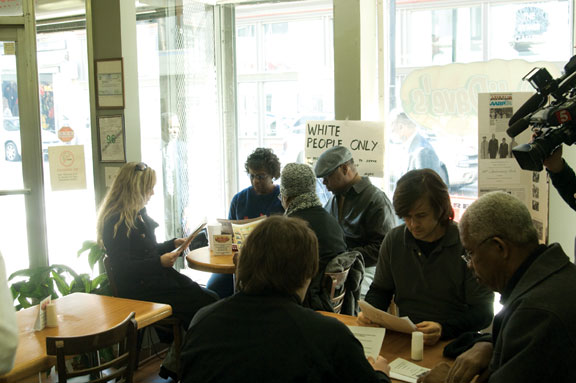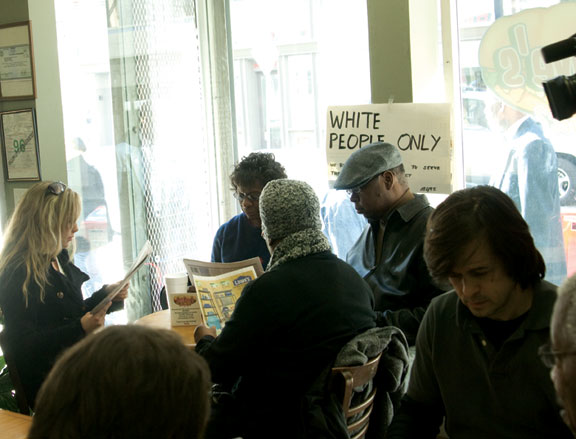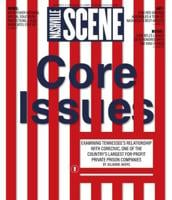Black men and women and a sprinkling of whites sit quietly at a downtown eatery during the busy lunch hour, reading their newspapers while a crowd of hecklers screams epithets at them. A sign states clearly: White People Only."Look at me, boy! Stop pretending to read that paper. You know you niggers cain't read!" an angry man screams.
A heckler shoves the chair of a young white man. "What you doing with these niggers? You're a nigger lover, aren't you?" The chair rocks and the white man grabs the table to keep from falling.
"Get out of here, you bunch of trouble-makers! They should shove you all in jail."
The black protesters never look up, never make eye contact. This infuriates the hecklers, who redouble their efforts to get some reaction, any reaction.
"You listen to me, get outta here!" The heckler rattles the chair of a black man who neither moves nor looks up into the angry face. "Why you going where you ain't welcome?" the frustrated heckler shouts. "Listen to me, look at me!"
Another heckler looms over a table where a black man and woman and a white girl sit. He grabs a hank of the white girl's long blond hair. "Maybe this will get your attention, you white bitch nigger-lover." He grinds a cigarette into her hair, while a companion grabs a shaker off the table and begins to frost the black woman's hair with white grains of salt.
"You're damned communists," one spittle-flecked heckler screams. "Get out of here. Cain't you read that sign? That says, 'whites only,' and you ain't white. Cain't you read, boy?"
As suddenly as it began, the heckling ends. The date is Jan. 15, 2010. The place is Dave's Deli on Fifth Avenue at the entrance to the downtown Arcade, the closest thing to a lunch counter left in downtown Nashville.
The hecklers are all black, all veterans of the original Nashville sit-ins that rocked the segregated South's status quo in 1960: former Metro councilman Kwame Leo Lillard, Allen Cason Jr., and Frederick Leonard. Fifty years ago this month, they were all on the receiving end of that racist abuse — only the pushes were punches, the cigarettes were lit, and the hatred was real.
The occasion was a walking tour of downtown sites where lunch tables once served "whites only" just five decades ago this month. For the purposes of the re-enactment, the protesters included Etta Simpson Ray, Matthew Walker Jr., Sandra Brown, Ernest Rip Patton, Alice Johnson and others who were involved in the 1960 sit-ins, as well as some white volunteers who had come to see living history. A few of them volunteered to join the oppressed at the tables. Not a single white person was willing to play the part of a heckler.
While these veterans of the civil rights movement, now in their 60s and early 70s, may be reliving their glory days with this street theater, there's a serious message here — a reminder of the adage that those who can't remember the past are doomed to repeat it. At least for this spring, the sit-ins are being recognized on the fiftieth anniversary of the events, with conferences at both Vanderbilt and TSU and exhibits at the Tennessee State Museum and the Nashville Public Library. In other ways, though, Nashville seems as if it would rather forget those times that were shameful for whites and illustrious for African-Americans.
In 1960, the block of Fifth Avenue between Union and Church streets was lined with stores and bustling with shoppers, both black and white. Walgreen's, Woolworths, S.H. Kress, McLellan, Grant's and Cain-Sloan were all more than happy to take the money of black shoppers. All these stores had lunch counters. None, however, would serve blacks, who were denied access even to dressing rooms. A hungry black shopper had to either go home for lunch or carry a ham biscuit in his pocket.
But on Saturday, Feb. 13, 1960, some 124 black students from Fisk, Meharry, Tennessee A&I (now TSU) and American Baptist College converged on three downtown lunch counters and did something revolutionary: They asked for service. They were rebuffed but sat down anyway in the stores and eventually left peaceably.
They repeated the procedure every few days, and by Feb. 27, their numbers had grown. So had the ranks of the opposition. At McLellan and Woolworths that day, white hecklers met the students' nonviolent protest with slurs, shoves and beatings. The record stands for the ages in black-and-white newspaper photos and on-the-spot footage: white fists and taunts raining on stoic black figures, all for the right to eat a hamburger. The city cringed; the nation noticed.
All these stores except Walgreen's are now gone, and Walgreen's no longer has a lunch counter — those iconic spots with stools that spun around, a soda fountain, and a grill where hamburgers and cheese sandwiches were cooked back in the day. The current manager of Walgreen's (who no longer wears a little paper hat while flipping burgers) had been scheduled to speak at the event, but he popped briefly out of the store to whisper to one of the organizers and scurried back inside.
"This is corporate America," Lillard commented after he got the whispered message. "The manager can't speak."
After the re-enactment, Lillard led the group around the corner to a spot on Union and pointed to a blank brick wall across the street, partially obscured by scaffolding, more evidence of Nashville's vigorous rush to obscure all traces of its past. That spot was once the Moon-McGrath store, one of the sites of the original sit-ins.
The Nashville Student Movement Legacy Foundation, which sponsored the re-enactment and walking tour, was founded to keep the memory of those days alive for future generations. It is pushing for Nashville to embrace the achievements of the civil rights movement that took place here. The sit-ins were a critical moment when Nashville sat right in the crosshairs of history. The members of the foundation were among the 14 Tennessee A&I students who went on to join the 1961 Freedom Rides, aimed at desegregating bus waiting rooms in the Deep South.
"We knew that we probably would not return, sure enough," when they left for Alabama in 1961, Allen Cason Jr., told the Scene. The Nashville Riders wrote last letters to their parents. "It hurt them, too," he said. "But we were ready to give our lives for something we believed in, to help the world. And we couldn't keep living the way we were."
When Cason came back to Nashville after a jail stretch in Mississippi, he found that he and the other 13 students had all been expelled from Tennessee A&I and the city was still largely segregated. It was a low point in his life, he said. On his way back home to Florida, he was once again arrested, "and did hard time alone."
In 2008, 47 years later, TSU finally reversed those expulsions and awarded all 14 of the former students honorary doctorate degrees. After the ceremony, Cason, who now proudly puts Dr. before his name, said the survivors sat down together over lunch and hatched the idea of creating a foundation to keep alive the legacy of nonviolent resistance and the history of that era.
They have taken the sit-in re-enactment elsewhere in Nashville, trying to educate young people about "what we went through and how we felt" and how hard it was to remain nonviolent in the face of violence, Cason said.
"They took it in," he said, with more hope than confidence.
Mary Jean Smith, however, another Legacy Foundation member, told the Scene she had talked to "kids, and grown people, in recent months. They had no idea this went on. Some don’t even want to know."
Meanwhile, the foundation is asking for more historic signage, a downtown monument, a walking trail of the sit-ins with brochures in downtown hotels and the convention center, and other ways of recognizing the struggle.
"Reparations, if you will," Lillard said.
In 1995, a plaque was placed in the Court House. At present, though, there are only two historical markers to commemorate the sit-ins — one on the edge of the Fisk campus, the other at the former site of the First Colored Baptist Church, Capitol Hill. It was at that church, at the corner of Charlotte and Eighth avenues, where the students learned the discipline of nonviolent civil disobedience, where they gathered before and after the protests, where strategy was developed and tactics discussed. The site is now — what else? — a parking lot. The historical marker lists heavily to the west.
On today's Church Street, reminders are few of those days of fear and wonder, when a handful of teenagers faced down everything the white South could throw at them, and won. The cost was great, to be sure. One of those 14 students, Cason said, was beaten so severely in Montgomery during the Freedom Rides that he died soon after. He did not live to imagine getting an honorary degree, let alone to collect it. Nor did three other students.
But if the sites of the city's civil rights triumphs have largely vanished over the years — as has downtown's former standing as a glamorous, thriving retail hub — the re-enactment showed that some things in Nashville have undoubtedly changed for the better. Fifty years after the sit-ins, on an ordinary January day, black and white Nashvillians did something that would have gotten them jailed or beaten just a half-century ago this month: They stood together. In the long run, that may be the monument that matters.
Email editor@nashvillescene.com.









